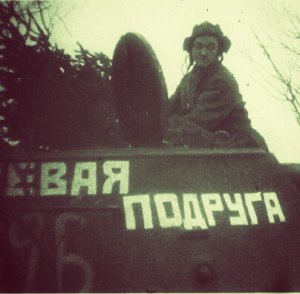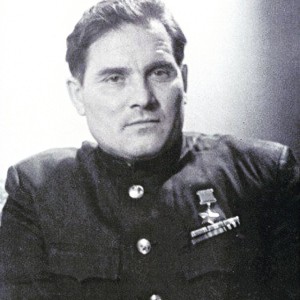This article was originally published in 2015 to mark the 70th anniversary of Victory Day, marking the triumph over Nazism in World War II. We are republishing this today, the 77th Victory Day, at a time when the reality of the fight against fascism is being gravely distorted, erasing the principal role played by the Soviet Union in the war and sanitizing the legacy of Nazi collaborators. Below are stories of heroism displayed by Red Army soldiers in the battle against the Nazi invaders that are virtually unknown in the United States.
The ‘Fighting Girlfriend’

In April of 1943, 38-year-old Ukrainian Mariya Oktyabrskaya (originally from a peasant family in the Crimean Peninsula) learned that her husband had been killed on the eastern front two years before. The devastating news angered her to a point where to vent her rage she sold all her possessions and used the money to buy a T-34 medium tank for the Red Army on the condition that she’d be the driver.
After five months of training, Oktyabrskaya and her tank, the “Fighting Girlfriend,” joined the 26th Guards Tank Brigade near Smolensk, Russia. On October 21, 1943, Oktyabrskaya and her tank took part on an assault on the German lines. Any impression that the “Fighting Girlfriend” was merely a propaganda ploy or a stunt were swept away when she smashed Nazi machine gun nests and artillery pieces to smithereens.
On several occasions when Oktyabrskaya’s tank was damaged she would jump out and make repairs to get her crew back in the fight. Oktyabrskaya’s luck ran out in the village of Shvedy near Vitebsk while, when crushing German trenches and machineguns, her tank was hit by an anti-tank shell. After repairing the tank’s tracks a shell exploded near Oktyabrskaya and she was hit in the head with shrapnel. She remained in a coma for two months before dying on March 15, 1944.
Mariya Oktyabrskaya was posthumously awarded the title Hero of the Soviet Union.

Escaping from the Nazis in a Nazi bomber
When 27-year-old Mordovian Senior Lieutenant Mikhail Devyatayev (from the Romanian speaking minority in the Western USSR) bailed out of his burning aircraft, he hit the plane’s stabilizer, knocking himself unconscious. Landing in German held territory, he was soon captured. After being held first at the Łódź concentration camp in Poland, then later the Sachsenhausen concentration camp in Germany, Devyatayev knew being an ace pilot put his life in danger, so he managed to trade identities with a dead Soviet infantryman.
With his new identity Devyatayev was transferred to a camp in Usedom, an island in the Baltic Sea, working as part of a forced labor crew for the German missile program, repairing runways and clearing unexploded bombs by hand. It was there that he along with other Soviet nationals became convinced that it would be better to die trying a daring escape than die as prisoners.
So, on February 8, 1945, Devyatayev and nine other Soviet POWs went to work on the runway where one member of the group killed the guard with a crowbar and stripped him of his uniform. Devyatayev, the only pilot among them, lead them to the hangar where they stole the camp commandant’s Heinkel Bomber.
Flying east, the escapees evaded German fighters and landed in Soviet territory. The escapees provided crucial information about the German missile program, including the V-2 rocket, the first man-made object to cross the boundary of space. However, Soviet law enforcement thought it was impossible that prisoners could have taken over an airplane and escaped without cooperation from the Germans. Believing the escapees to be spies, Devyatayev and the others spent the remainder of the war in penal military units or prison.
Later when the head of the Soviet Space Program, Sergey Korolyov, personally argued that the Soviet space program owed its efforts to the information provided by Mikhail Devyatayev and the other escapees, Devyatayev’s name was finally cleared.
On August 15, 1957, Devyatayev, the youngest of 13 children born to a Mordovoan peasant family, became a Hero of the Soviet Union and an honored citizen of the Mordovian Autonomous Socialist Soviet Republic. Within months, the USSR launched the first ever artificial satellite into Earth orbit. Devyatayev died in 2002 at the age of 85.
Lethal Soviet ‘Night Witches
On October 8, 1941, Joseph Stalin ordered the creation of three all-women’s aviation regiments. One in particular, the 588th Night Bomber Regiment, became more famously known by their World War II German nickname, Nachthexen, or Nightwitches (pictured above). From June 1942 to May 1945 the 588th flew nonstop missions. One woman, Nadezhda Popova, flew 18 missions in one night.
In a war where the latest technology was applied to the weapons of war, the 588th were given Polikarpov Po-2 biplanes to fly, usually used for training or crop-dusting. The light Po-2s were held together with wood, wire, and fabric, carried no guns or parachutes, and only had a cruising speed of 68 mph and maximum speed of 98 mph. Often when the plane went in for an attack the pilot would bring the engine to an idle or shut it off completely to silently glide in to drop six bombs at a time. The bombardier would then have to climb out to crank-start the engine in midair.
For their bravery on the Taman peninsula, during the battle of the Caucuses, the 588th Night Bomber Regiment was renamed the 46th Taman Guards Night Bomber Regiment. Together, they flew 24,000 sorties and dropped over 23,000 tons of bombs on the invaders. At its height, the 588th/46th Taman Guards numbered forty pilots, thirty were shot down. None were captured. Twenty three were awarded the title Hero of the Soviet Union.






